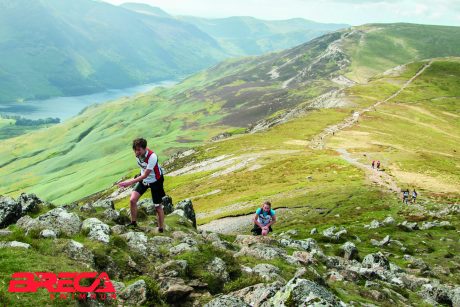Swimrun: your next challenge?
If you haven’t yet heard of swimrun, you are about to. The Swedish endurance sport has hit the UK big time this summer. What started as a drunken bet in Sweden just over a decade ago is now the latest international endurance sport phenomenon.
Swimrun does exactly what it says on the tin: athletes swim and run across a set course. But unlike aquathlons (which are essentially triathlons without the bike leg), swimrun races involve non-stop multiple swims and runs. Competitors must be experienced open water swimmers as well as confident trail runners.
Swimrun originated in Sweden with the Ötillö, which literally means “island to island”. In 2002 a group of friends challenged each other to race 75km across the islands of the Stockholm archipelago to get to a hotel in Sandhamn. The last one there would buy the drinks. It took them over 24 hours. In 2006 the race became a formal event, and it has now expanded into the Swimrun World Championship. One of the toughest adventure races in the world, teams of two swim between 26 islands and run over them, covering a total swim distance of 10km and 65km of trail running.
But you don’t have to travel to Sweden to compete in a swimrun event. Although Sweden leads the world in the number of races, the sport is spreading across Europe and the world, with plenty of races to choose from in the United Kingdom.
Why you should do it
Put simply, these races take place in some of the most stunning and remote scenery in Europe. If you want to swim across an archipelago in Norway, down a Swiss mountain valley or between the islands of the Outer Hebrides then there is a race for you. “Swimrun is fantastic for open water swimmers,” says Ben de Rivaz, organiser of Breca Swimrun in the Lake District. “The swim routes are challenging and really exciting to navigate. Also, it is one of the only multi-phase sports that rewards strong swimmers due to the swim distances involved.”
As open water swimmers we are used to racing on our own. Swimrun is a different kind of experience as athletes compete in pairs. “It is a team sport,” says Alan Anderson of SwimRun UK. “The camaraderie of swimrun is phenomenal.”
Swimrun straddles nicely a number of activities: wild swimming, trail running, adventure racing. There are elements that are akin to triathlon, but event organiser Paul McGreal of Swimrun Scotland is adamant that the sport is a completely different beast to triathlon: “This is not like a triathlon. It is very much more relaxed and much less contrived. It is just more adventurous.”

Where can I do it?
Handily there are some pretty impressive locations in the UK for swimrun events – and many of them also happen to be iconic open water swimming locations. Loch Lomond, Loch Ness and Buttermere are all host to swimrun races this summer. You can even sign up to a swimrun event in central London.
“We have an amazing playground in these islands,” says Alan Anderson. “Loch Lomond is island to island. One minute you are surrounded by fish, the next minute you might meet a heron. And then you are running through the trees with wallabies.” And if running with wallabies doesn’t intrigue, then nothing will.
I love swimming. But running…?
Don’t worry, you don’t have to dive in to the full Ötillö-style 65km of running. Not all events are gruelling endurance challenges: short course races are the perfect introduction to the sport.
“We want to encourage people to give swimrun a go,” says Anderson, whose short distance races typically comprise 3km of swimming and 10km of running.
Chloe Rafferty of Love SwimRun Llanberis agrees. “I wanted to put on a smaller race that would be more achievable by a bigger demographic. Love SwimRun Llanberis is only 16km in total, with 3.5km of swimming and 12.5km of running.”
And remember that those distances are broken down into smaller runs. You won’t be running the full distance at once.
How do I train for swimrun?
If you are an experienced open water swimmer then the challenge of swimrun will be upping your run training so you are confident in tackling the distances of your chosen event. As with any sport, training for swimrun is all about being specific. “Run a bit, swim a bit, and certainly swim in open water – but make it even more specific,” says McGreal. “The thing that catches people out is the running and swimming combined – the constant transition between those disciplines is fatiguing. The way to train for swimrun is to go and do some swimrun.”

What are the rules and what kit will I need?
First of all, swimrun is a team event. You are going to have to make sure that you and your teammate are evenly matched in terms of speed – both swimming and running. Swimrun rules state that teammates can be no more than 10m apart in the water and 100m apart on land. “The suffering and elation entailed are shared experiences,” says de Rivaz. “Teamwork plays an integral role in success. Above all, it is great fun!”
Wetsuits are also mandatory. The race is non-stop – so no getting changed between swims and runs. That means you run in your wetsuit and swim in your shoes. There will also be no time to take off your hat and goggles so you will also run in those.
Hand paddles and pull buoys are allowed on the swim (to help combat that sinking feeling of swimming in shoes) so you’ll need to find a way of attaching those to yourself when you are running.
As you are going to be swimming in your shoes, as well as running on some pretty technical off-road terrain, you are going to need a pair of lightweight, well-draining trail shoes. “Wear the lightest shoes you can find,” says de Rivaz. “They drain quickly and are less prone to drag in the water.”
Most races have a mandatory kit list of whistle, map, compass and first aid bandage – and a drybag, backpack or bumbag to carry them all in. Some competitors also wear hydration bladders rather than just rely on water at aid stations.








